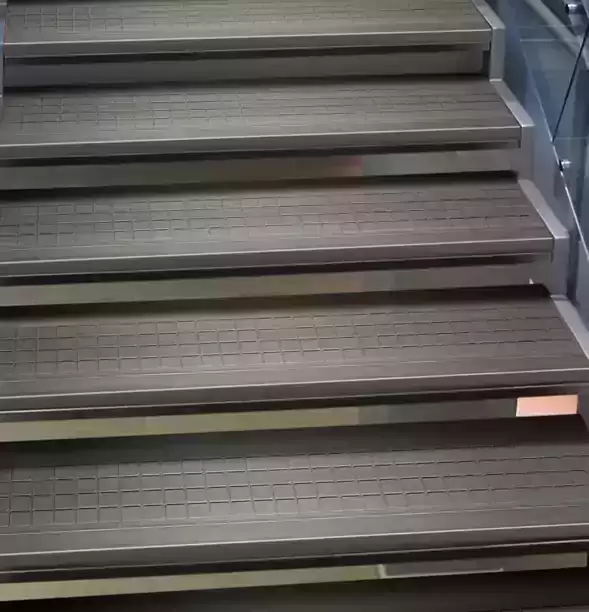Materials used in the design of interior stairs,
When designing a commercial ladder, there are many options to consider when choosing the right materials.
In this article, we’ll look at the different types of stair materials, specific types of rubber for stair tread options, and customization opportunities.
When choosing stair materials, there are many things to consider, but the most important factors include safety, aesthetics, subfloor conditions,
The fact that some stairs are not a perfect 90 degree angle, the amount of foot traffic, and of course the cost.
Blending these considerations together will help you narrow down the right choice of stair material.
Beyond aesthetics, choosing flooring materials for your space should take into account performance, maintenance, and life cycle cost considerations.

Types of staircase materials
Some common materials used in stairs:
Cement
carpet
Metal
wood
eraser
Cement
Concrete is sometimes used in areas out of sight such as fire stairs.
Concrete is growing in popularity in industrial-chic spaces, however, there are considerations to keep in mind.
Concrete is economical, but it can be slippery when wet. Also, there is little or no benefit in sound attenuation, which means the material does nothing to reduce noise pollution.
carpet
Carpet also has its pros and cons, as it can be easily replaced when changing other decor, and the cushioning makes it quiet underfoot.
However, carpets can wear quickly on steps and require heavy maintenance, and are commonly used in offices and institutions such as libraries.

Metal
Metal is usually only used in industrial areas or fire-resistant staircases.
Metal staircases are usually very noisy and require significant maintenance to prevent corrosion.
Even indoor metal stairs are subject to corrosion, and metal can be difficult to install due to the lack of flexibility in the material.
wood
Wood is certainly a traditional choice and offers a warm luxury,
but it is easily damaged and can be difficult to maintain, like any solid wood floor.
It can also be expensive to install and is not usually used in commercial settings.
rubber stairs
Rubber or flexible stairs have multiple benefits, as they are easy to clean,
quiet, comfortable for feet, and can last from 10 to 15 years.
And due to its high coefficient of friction, which resists slipping, it is a popular choice for schools and medical facilities.

Certain types of rubber for stairs
Thermoplastic vinyl
Thermoplastic vinyl, also called TV-type, is made all-vinyl and is a high-quality,
cost-conscious product for a flexible stair system.
It is also an extruded product and can be made into treads, risers, and noses.
But keep in mind that it is not among the heavier construction variants,
and there are usually options to add poorly visible abrasive tape inserts to resist color and slip.
TV noses can be added to stairs made of other materials to add visual contrast,
calmness and slip protection.
The risers and treads must be installed separately,
and you should fill the nose of each tread with epoxy to prevent it from bending and breaking.
The extra work makes TV more difficult and expensive to install,
but overall it is a less expensive flexible staircase system that offers good overall performance.

thermoplastic
Thermoplastic is a mixture of vinyl and rubber that is classified as rubber and is called type TP.
Like the TV type, you don’t usually find a tread and riser combination.
Alternatively, TP is available as a treated, matching up-and-nose,
and can be made with low-visibility abrasive strip inserts for color contrast and slip resistance.
TP noses can be used on stairs made of other materials to make them more durable and less slippery,
which helps with some compliance requirements.
Like type TV, type TP is also an extruded material and requires epoxy to be used to fill the nose of each tread to prevent flexing and breakage.
Because the TP type incorporates rubber, it is usually more expensive than the TV type,
this product is more durable and stands up better to foot traffic than the TV type,
so there are definite positive aspects.
Thermoplastic rubber – TS type
The third category is called thermoplastic rubber, or type TS,
and is made of vulcanized rubber.
Instead of extruding, they are heat set and shaped,
making them more durable and better for high traffic areas than other options.
For more architectural news


 العربية
العربية